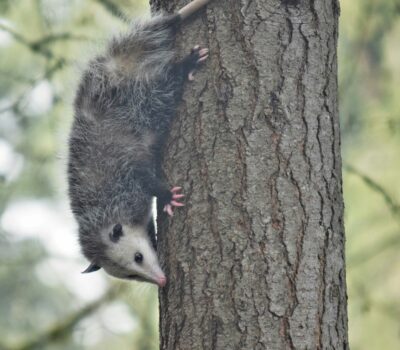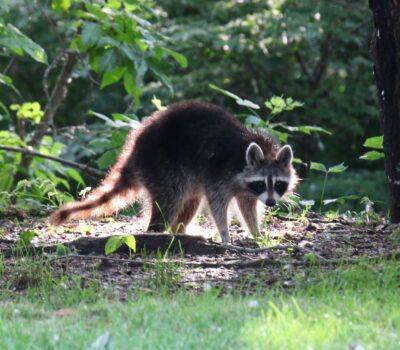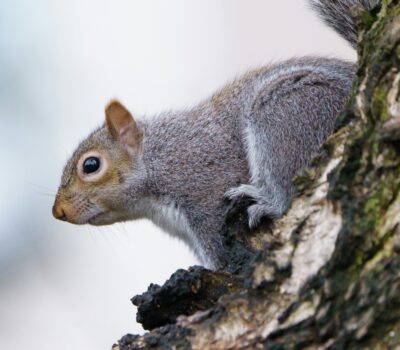Ask A Naturalist: Mammals
Did you know that the Gateway Nature Preserve is an ecoEXPLORE Hotspot? This means that it is a great place to explore and submit wildlife observations that are especially helpful to scientists. ecoEXPLORE has over 500 Hotspots across North Carolina. It is so exciting that we can have such a place right in the middle of the city!
Every two months, there is a different season of exploration when explorers can focus on a theme, make observations, and submit them for scientific study by making an ecoEXPLORE account and uploading photos. Starting in November through December, ecoEXPLORE’s badge will be themed for Mammalogy Season. Mammalogy is the study of warm-blooded vertebrates that have hair or fur, produce milk to feed their young, and have more complex brains than other animals. Some of the mammals you can observe at Gateway Nature Preserve include but are not limited to: Virginia Opossum, Raccoon, and Gray Squirrel.
Virginia Opossum
Did you know that opossums have 50 teeth? More than any other North American mammal. Opossums are nocturnal and they live in a wide range of habitats, from sea level to elevations of 10,000 ft. They spend the day inside their den. They do not hibernate but can spend long periods of time inside their shelter if the temperature gets too cold.
Opossums are solitary except during mating season. “Unlike other mammals, the gestation period is very short, resulting in embryonic young that must pull themselves with their forelimbs to the marsupium, or pouch, where they must attach themselves to a nipple in order to survive.” A litter can be as big as 14, but only half or less survive. Babies are as big as a house mouse after 55 days of being born.
Have you heard the phrase “Playing Possum?” Opossums will face their predators with an open mouth and hissing sound. If they are grabbed by the predator, they will feign death while defecating and emitting a foul smell. This often causes the predator to release it. Opossums are misunderstood creatures due to their appearance. People don’t realize they’re very beneficial mammals. They eat thousands of ticks a week and feast on roaches, slugs, snakes, mice, and rats.
Raccoons
Have you ever caught a raccoon eating out of your garbage? Most people think of raccoons as a pest because they can make a mess of their garbage, but these critters are highly intelligent and resourceful. Did you know that these mammals are one of North Carolina’s most important furbearers? They currently generate more revenue than any other furbearer in the state. Raccoons are legally trapped and hunted in the state.
Raccoons can live in a wide range of habitats because they are very adaptable. They can be found all over cities as well as rural areas. They are most abundant in habitats near water such as bottomland forests, hardwood swamps, and marshes. Females can nest in dens, burrows, or ledges. Raccoons can enter a deep sleep stage in colder habitats, but they do not hibernate. In North Carolina however, raccoons are more active in the winter due to warmer temperatures.
It is becoming more common for raccoons to be active throughout the day rather than just at night. This is due to the abundance of food available and the lack of natural predators. They can become habituated (they associate humans with food) if food such as pet food, bird feeders, or garbage is left out unsecured.
Besides being trapped and hunted, raccoon mortality is also caused by diseases such as canine distemper and rabies. Raccoons with rabies appear lethargic, may lose awareness, and become paralyzed. It is important to stay away from raccoons that appear rabid and contact local health officials to handle the animal.
Gray Squirrel
North Carolina has five species of squirrels throughout the state, the Gray Squirrel is the most common. It was adapted as the state mammal in 1969! It can be entertaining to watch squirrels but a lot of the time they can also become nuisances and cause damage to property. Their habitat is also widely spread, they can live in rural and urban areas alike. Their population is regulated by food availability. When food sources are more abundant females will produce larger litters.
Gray squirrels prefer nesting in hardwood tree cavities and living in woods with an ample supply of nuts. They are very vocal animals and communicate with a variety of calls and body movements.
Squirrels can become a nuisance if their food source is near human property. It is important to remove access to food sources such as bird feeders or pet food to prevent property damage. You can also cut back tree limbs to prevent them from jumping onto the roof of the house. Closing off any entries to the house also prevents squirrels from entering and damaging your property. To learn more about how you can prevent damage from squirrels visit https://www.ncwildlife.org/species/gray-squirrel
Learning to live with these animals can be rewarding. Even though they are usually considered nuances and pests, they can be very beneficial to our environment and to our lives! Next time you see one of these critters make sure to snap a photo and upload it to your ecoEXPLORE account. This is a fun activity to do with kids of all ages in your own backyard!
Resources:
https://www.ncwildlife.org/catalog-category/mammals
https://www.ncwildlife.org/species/gray-squirrel
https://www.ncwildlife.org/species/virginia-opossum


